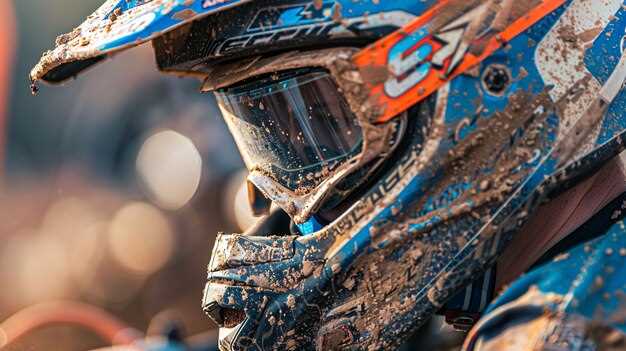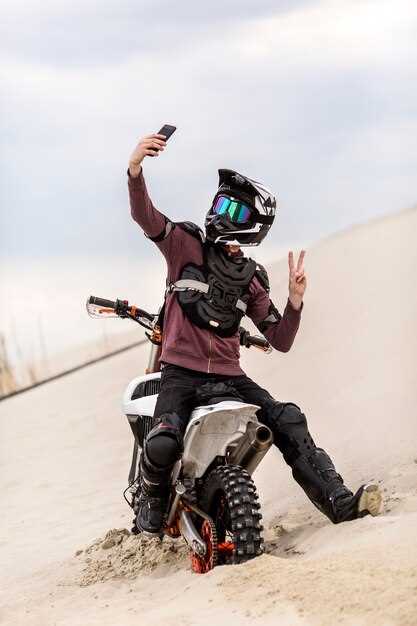
Motocross is an exhilarating sport that combines speed, skill, and adrenaline, attracting riders from all walks of life. However, the thrill of racing through rugged terrains comes with significant risks, making safety equipment essential for every rider. The right protective gear not only enhances performance but also minimizes the chances of severe injuries.
Understanding the importance of safety, manufacturers have developed specialized equipment tailored to the unique demands of motocross riding. From helmets that safeguard the head to boots designed for optimal ankle support, each piece of gear plays a critical role in protecting the rider. This article explores the top protective gear that every motocross enthusiast should consider, ensuring a safe and enjoyable riding experience.
Investing in quality protective gear is not just a personal choice; it’s a commitment to safeguarding one’s health. Each item, whether it’s knee guards or body armor, is crafted to absorb impact and reduce the risk of injury from falls and collisions. Riders owe it to themselves to equip their passions with the best protection available, allowing them to focus on what truly matters: the ride.
Choosing the Right Helmet for Maximum Head Protection
Selecting the appropriate helmet is crucial for motocross riders, as it provides the first line of defense against head injuries. With various options available, understanding the essential features of a helmet is vital for ensuring safety during rides.
When choosing a helmet, consider the following factors to maximize head protection:
| Factor | Description |
|---|---|
| Safety Standards | Ensure the helmet meets or exceeds recognized safety standards such as DOT, ECE, or Snell. These certifications indicate that the helmet has undergone rigorous testing for impact resistance. |
| Fit | A proper fit is essential for effectiveness. The helmet should sit snugly on the head, with no gaps. Try different sizes and shapes to find the best match for your head. |
| Material | Look for helmets made with high-quality materials like fiberglass, carbon fiber, or polycarbonate. These materials provide superior protection while keeping the helmet lightweight. |
| Weight | A lightweight helmet reduces fatigue during long rides. However, ensure that lightweight does not compromise protection. Balance is key. |
| Ventilation | Good airflow can enhance comfort, especially during strenuous riding. Consider helmets with multiple vents that allow for cooling without compromising structural integrity. |
| Visor | The visor protects against sun and debris. Look for an adjustable visor that can be positioned to minimize glare while maintaining visibility. |
| Additional Features | Consider helmets with removable liners for ease of cleaning, communication system compatibility, and emergency release cheek pads for safe removal in case of an accident. |
Ultimately, investing in a high-quality helmet designed specifically for motocross can significantly reduce the risk of head injuries. Prioritize safety and comfort to ensure an enjoyable riding experience.
Exploring the Benefits of Body Armor for Impact Resistance

Body armor is a critical component of protective gear for motocross riders, providing essential impact resistance that enhances safety levels during high-speed races and extreme conditions. One of the primary benefits of body armor is its capability to absorb and disperse energy from collisions. This reduces the risk of severe injuries by minimizing the force transmitted to the body upon impact.
Modern body armor is designed with various advanced materials, such as polyethylene and Kevlar, which are lightweight yet incredibly strong. This combination allows riders to maintain mobility and comfort without sacrificing protection. The ergonomic design ensures that the armor fits snugly against the body, enabling full range of motion necessary for maneuvering on the track.
In addition to basic impact protection, body armor often includes features like ventilation systems that help regulate body temperature during intense physical activity. This is crucial for maintaining optimal performance and concentration levels. Furthermore, many models offer additional protection for vulnerable areas, such as the chest, back, shoulders, and ribs, addressing the common impact zones in motocross.
Another significant advantage of body armor is its ability to promote rider confidence. Knowing that they are equipped with high-quality protective gear allows riders to push their limits and focus on their performance rather than worrying about potential injuries. This psychological benefit can lead to improved racing outcomes and overall enjoyment of the sport.
Ultimately, investing in body armor is essential for motocross riders who prioritize safety and seek to reduce the risk of injury. With the right armor, they can navigate the challenges of the track more effectively, enhancing both their performance and safety on the bike.
Finding the Best Protective Gloves for Enhanced Grip and Safety
Choosing the right gloves is crucial for motocross riders looking to enhance grip and ensure safety during their rides. The best protective gloves should combine comfort, durability, and superior grip to effectively manage the demands of off-road riding.
Material Selection plays a significant role in glove performance. Many high-quality motocross gloves are made from synthetic materials that offer excellent abrasion resistance while remaining lightweight. Look for gloves with features like reinforced palms to provide an extra layer of protection against wear and tear.
Grip Technology is another essential feature. Gloves with silicone or rubberized prints on the fingers and palms enhance grip on the handlebars, allowing for better control over the bike. This is particularly important in wet or muddy conditions where a secure hold is vital for maintaining balance.
Fit and Comfort cannot be overlooked. Gloves should fit snugly but not too tightly, allowing for free hand movement without sacrificing protection. Many gloves come with adjustable closures or elastic cuffs to ensure a secure fit, which helps prevent dirt and debris from entering the gloves.
Ventilation is also a key factor in glove selection. Riding in hot conditions can lead to sweaty hands, which may compromise grip. Look for gloves that feature mesh panels or breathable fabrics to keep hands cool and dry during extended rides.
Finally, consider the level of padding and protection offered. Some gloves come with additional padding on the knuckles and palms, which can absorb impacts and reduce the risk of injury during falls. This added protection is especially valuable for riders tackling rough terrains.
In summary, when searching for the best protective gloves, focus on materials, grip technology, fit and comfort, ventilation, and added protection. Making the right choice in gloves not only enhances performance but significantly contributes to overall safety on the motocross track.
Selecting High-Quality Boots for Ankle Support and Protection
Choosing the right boots is crucial for motocross riders, as they play a vital role in providing ankle support and protection. A well-designed pair of motocross boots can prevent injuries and enhance overall riding performance.
When selecting high-quality boots, consider the following factors:
- Ankle Support: Look for boots with reinforced ankle protection and a secure fit. Features such as internal ankle braces or external ankle armor can provide the necessary support during rides.
- Material: High-quality materials, such as leather or synthetic composites, offer durability and resistance to abrasion. A waterproof or breathable lining is also beneficial for comfort in varying weather conditions.
- Closure System: Opt for boots that feature multiple closure systems, like buckles or Velcro straps, ensuring a snug and adjustable fit. This prevents movement within the boot, providing better stability.
- Sole Design: A molded outsole with a grippy tread pattern enhances traction on the bike and prevents slips. Consider boots with non-slip soles specifically designed for motocross terrains.
- Weight: Lightweight boots can reduce rider fatigue over long periods. However, ensure that reduced weight does not compromise strength and protection.
- Comfort and Fit: Proper fit is essential for effective performance. Try on boots with the same socks you wear while riding. Ensure there is enough room for toe movement without being too loose.
- Brands and Reviews: Research reputable brands known for producing high-quality motocross gear. Reading customer reviews can provide insights into the durability and comfort of specific models.
Investing in high-quality boots tailored for motocross will enhance your safety and riding experience. Ensure that your chosen pair includes all essential features to protect your ankles and provide a stable foundation for your rides.
Importance of Goggles in Preventing Eye Injuries on the Track
Motocross is an exhilarating sport that comes with its own set of risks, particularly regarding rider safety. Among the essential protective gear, goggles play a critical role in preventing eye injuries while navigating rugged terrains at high speeds. The eyes are vulnerable to various hazards such as dirt, debris, dust, and even small rocks that can get kicked up by the tires of other bikes.
Wearing goggles serves as a barrier that protects the eyes from these airborne particles. Impact-resistant lenses are designed to absorb shocks and reduce the risk of injury in the event of an accident. Additionally, these lenses often feature anti-fog and anti-scratch properties, which ensure clear visibility during races. This is crucial, as impaired vision can lead to accidents, jeopardizing not only the rider’s safety but also the safety of others on the track.
Furthermore, goggles provide UV protection, shielding the eyes from harmful ultraviolet rays. Prolonged exposure to sunlight during outdoor races can lead to serious conditions such as cataracts and macular degeneration. Quality motocross goggles come with tinted or polarized lenses, optimizing vision under bright conditions and enhancing overall performance.
Comfort and fit are also important factors when choosing goggles. Properly fitted eyewear prevents dust and debris from entering, maintaining focus on the track. Adjustable straps and foam padding help secure the goggles in place, allowing riders to concentrate on their performance without distractions.
In summary, the importance of goggles in motocross cannot be overstated. They safeguard against eye injuries, enhance visibility, and provide comfort, enabling riders to focus entirely on their racing experience while minimizing the risks associated with the sport.
How to Properly Maintain and Replace Your Motocross Gear
Maintaining your motocross gear is essential for ensuring your safety and performance on the track. Proper care can extend the lifespan of your equipment while also providing optimal protection. Here are some guidelines to help you effectively maintain and replace your motocross gear.
Maintenance Tips
- Regular Cleaning: After each ride, clean your gear to remove dirt, mud, and sweat. Use mild soap and water for fabrics and specialized cleaners for hard surfaces.
- Drying: Allow your gear to dry completely before storing it. Avoid direct sunlight and high heat sources, as they can degrade materials.
- Avoid Chemical Damage: Keep your gear away from harsh chemicals, fuels, or solvents that can weaken the materials.
- Inspection: Routinely check your gear for signs of wear and tear. Inspect seams, padding, and fasteners, and address any issues immediately.
- Storage: Store your gear in a cool, dry place. Use gear bags or bins that allow airflow to prevent moisture buildup.
Replacement Guidelines
- Follow Manufacturer Recommendations: Each piece of gear has its own lifespan determined by the manufacturer. Pay attention to suggested replacement timelines.
- Signs of Wear: Replace gear that shows significant wear, such as fraying straps, cracked helmets, or compromised padding.
- Technological Advancements: Stay updated on new safety technologies. Upgrading to gear that incorporates the latest advancements can enhance protection.
- After a Crash: If you’ve experienced a fall, assess your gear carefully. Replace any damaged items, especially helmets, as internal impacts may not be visible.
- Size and Fit: As you grow or change shape, ensure your gear fits properly. Wearing gear that is too tight or too loose can impair mobility and safety.
By consistently maintaining your motocross gear and knowing when to replace it, you can ensure your safety and performance on the track. Prioritize care and regular assessments to get the most out of your investment.

